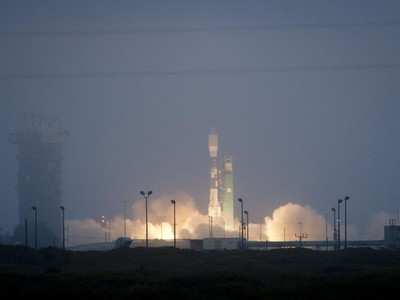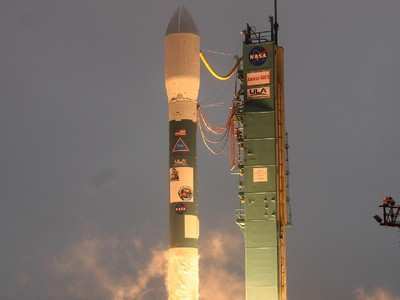Int'l Sat Launches From Vandenberg AFB
NASA's 'Age of Aquarius' dawned Friday with the launch of an
international satellite carrying the agency-built Aquarius
instrument that will measure the saltiness of Earth's oceans to
advance our understanding of the global water cycle and improve
climate forecasts.

The Aquarius/SAC-D observatory rocketed into space from
Vandenberg Air Force Base in California atop a United Launch
Alliance Delta II rocket at 7:20:13 a.m. PDT. Less than 57 minutes
later, the observatory separated from the rocket's second stage and
began activation procedures, establishing communications with
ground controllers and unfurling its solar arrays. Initial
telemetry reports show the observatory is in excellent health. The
SAC-D (Satélite de Aplicaciones Científicas)
observatory is a collaboration between NASA and Argentina's space
agency, Comisión Nacional de Actividades Espaciales
(CONAE).
"Aquarius is a critical component of our Earth sciences work,
and part of the next generation of space-based instruments that
will take our knowledge of our home planet to new heights," said
NASA Deputy Administrator Lori Garver. "The innovative scientists
and engineers who contributed to this mission are part of the
talented team that will help America win the future and make a
positive impact across the globe."

Aquarius will make NASA's first space observations of the
salinity or concentration of salt at the ocean surface, a key
missing variable in satellite studies of Earth. Variations in
salinity influence deep ocean circulation, trace the path of
freshwater around our planet and help drive Earth's climate.
"Data from this mission will advance our understanding of the
ocean and prediction of the global water cycle," said Michael
Freilich, director of NASA's Earth Science Division in the Science
Mission Directorate at agency headquarters in Washington. "This
mission demonstrates the power of international collaboration and
accurate spaceborne measurements for science and societal benefit.
This would not be possible without the sustained cooperation of
NASA, CONAE and our other partners." In addition to Aquarius, the
observatory carries seven instruments that will monitor natural
hazards and collect a broad range of environmental data. Other
mission partners include Brazil, Canada, France and Italy.
"This mission is the most outstanding project in the history of
scientific and technological cooperation between Argentina and the
United States," said CONAE Executive and Technical Director Conrado
Varotto. "Information from the mission will have significant
benefits for humankind."
Aquarius will map the global open ocean once every seven days
for at least three years with a resolution of 93 miles (150
kilometers). The maps will show how ocean surface salinity changes
each month, season and year. Scientists expect to release
preliminary salinity maps later this year. Aquarius will measure
salinity by sensing thermal microwave emissions from the water's
surface with three microwave instruments called radiometers. When
other environmental factors are equal, these emissions indicate the
saltiness of surface water. A microwave radar scatterometer
instrument will measure ocean waves that affect the precision of
the salinity measurement. Because salinity levels in the open ocean
vary by only about five parts per thousand, Aquarius will be able
to detect changes as small as approximately two parts per 10,000,
equivalent to about one-eighth of a teaspoon of salt in a gallon of
water.

During the next 25 days, the Aquarius/SAC-D service platform
will be tested and maneuvered into its final operational,
near-polar orbit 408 miles above Earth. Science operations will
begin after the observatory's instruments are checked out. This
commissioning phase may last up to 65 days.
Aquarius was built by NASA's Jet Propulsion Laboratory in
Pasadena, CA, and the Goddard Space Flight Center in Greenbelt, MD.
NASA's Launch Services Program, at Kennedy Space Center in Florida,
managed the launch. JPL will manage Aquarius through its
commissioning phase and archive mission data. Goddard will manage
Aquarius mission operations and process science data. CONAE is
providing the SAC-D spacecraft, optical camera, thermal camera with
Canada, microwave radiometer, sensors from various Argentine
institutions and the mission operations center. France and Italy
also are contributing instruments.
 ANN's Daily Aero-Linx (05.02.24)
ANN's Daily Aero-Linx (05.02.24) ANN's Daily Aero-Term (05.02.24): Touchdown Zone Lighting
ANN's Daily Aero-Term (05.02.24): Touchdown Zone Lighting Aero-News: Quote of the Day (05.02.24)
Aero-News: Quote of the Day (05.02.24) ANN FAQ: Contributing To Aero-TV
ANN FAQ: Contributing To Aero-TV NTSB Final Report: Cirrus Design Corp SR20
NTSB Final Report: Cirrus Design Corp SR20





